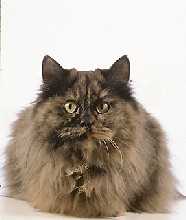| |
Update in treatment of dermatophytosis in dogs and cats
 |
 Picture: © Bayer Animal Health Picture: © Bayer Animal Health
|
 |
Dermatophytosis is a common problem especially in cats. Lots of controversial information concerning therapy have been published in the last couple years. Karen Moriello, one of THE experts in this field, gives a brandnew and critical review of the published studies and thus the current therapeutic options.
|
 |
 |
|  |
Based upon in vitro studies using isolated infected hairs and controlled or field in vivo studies, the following topical treatments were consistently found to be antifungal (i.e. antidermatophyte): lime sulfur (1:16), 0.2% enilconazole rinses, and a combined 2% miconazole/chlorhexidine shampoo. Animals or hairs were either bathed or rinsed once or twice weekly.
Itraconazole, griseofulvin and terbinafine were evaluated in controlled or field studies, most commonly involving cats.
Griseofulvin (50 mg kg1) was reported to cure infected animals in 41-70 days.
Itraconazole (10 mg kg1 once daily or in a combined daily/pulse therapy 10 mg kg1 once daily for 28 days and then week on/week off) was reported to cure infected animals in 56-70 days. Low-dose itraconazole (1.5-3.0 mg kg1) in 15-day cycles required 1-3 cycles (15-45 days).
Various doses of terbinafine (5-40 mg kg1) were reportedly used to treat dogs or cats. The higher doses of terbinafine (> 20 mg kg1) were required to achieve a mycological cure; the number of treatment days to cure varied from 21 to > 126 days.
Lufenuron was reported anecdotally to be an effective cure, however, this was not substantiated in controlled studies.
Finally, fungal vaccines were not found to be effective against challenge exposure, however, there is evidence that they may be useful in treatment protocols.
Source: Moriello, Karen A. (2004): Treatment of dermatophytosis in dogs and cats: review of published studies. In: Veterinary Dermatology 15 (2), 99-107.
Tell a friend
|
Print version
|
Send this article
|
|  |

Metastasis of a well differentiated perianal gland tumorPunica granatum associated with hepatotoxicosis in cattle Toceranib phosphate (Palladia®) in canine gastrointestinal stromal tumors Toceranib phosphate (Palladia®) in canine gastrointestinal stromal tumors Radioactive iodine uptake in hyperthyroid cats after rh-TSH Radioactive iodine uptake in hyperthyroid cats after rh-TSH Hypoechoic tissue changes in dogs with malignant prostatic lymphoma Hypoechoic tissue changes in dogs with malignant prostatic lymphoma Emphysematous gastritis in dogs and cats Emphysematous gastritis in dogs and cats Primary pulmonary histiocytic sarcoma in dogs Primary pulmonary histiocytic sarcoma in dogs Determining prognosis in canine sepsis Determining prognosis in canine sepsis  Correlation of plasma and tear glucose, creatinine and urea nitrogen in cats Correlation of plasma and tear glucose, creatinine and urea nitrogen in cats Perineal hernias in dogs - always a bilateral problem? Perineal hernias in dogs - always a bilateral problem? Pharmacokinetic of gabapentin in cats Pharmacokinetic of gabapentin in cats Follicular development of canine ovaries stimulated by eCG plus hCG Follicular development of canine ovaries stimulated by eCG plus hCG
|














